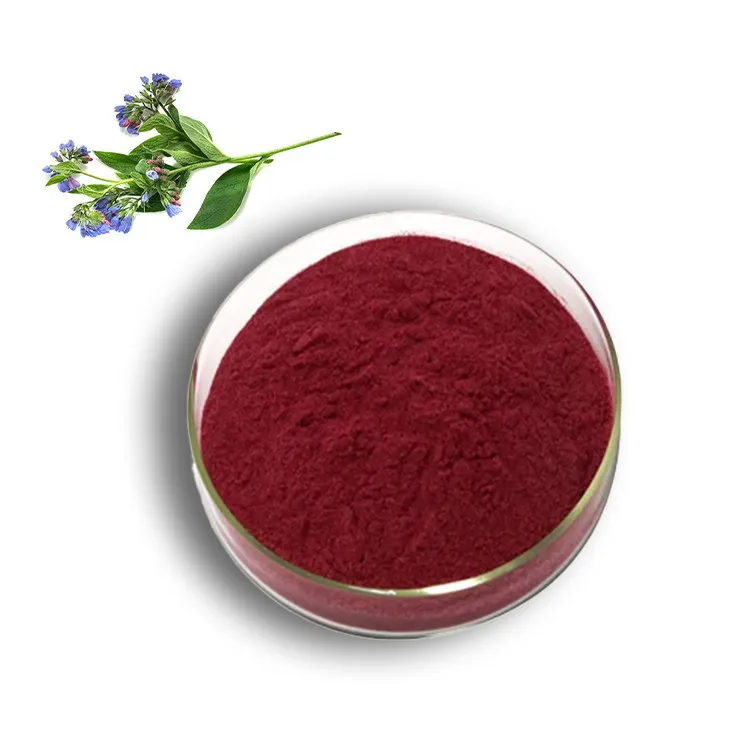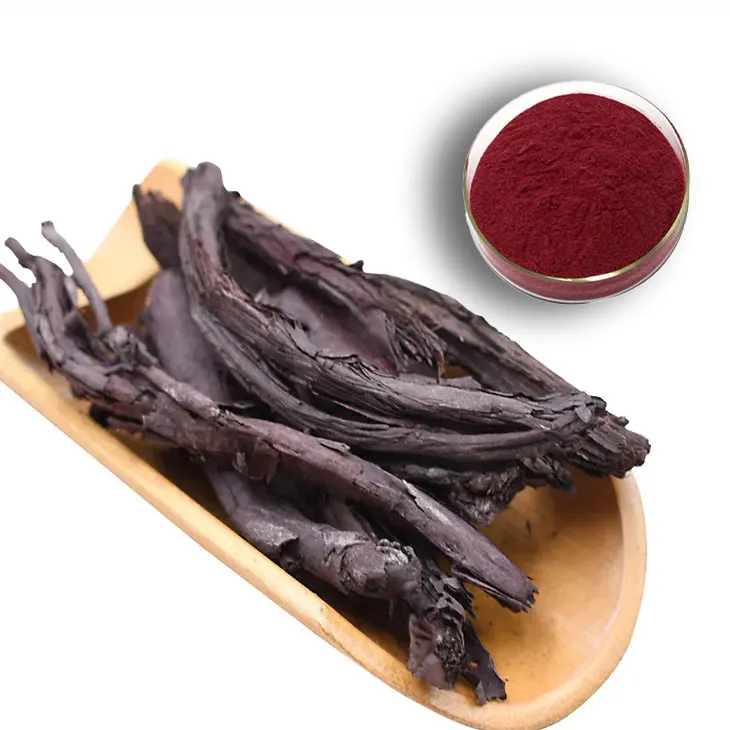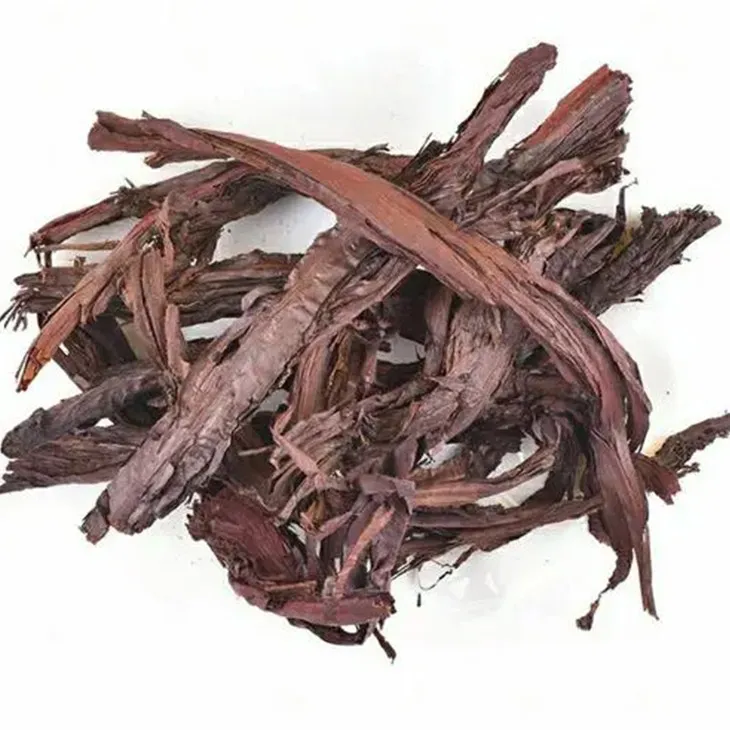- 0086-571-85302990
- sales@greenskybio.com
Mature shikonin flavor and natural shikonin.
2024-11-13

1. Introduction
Shikonin, a remarkable compound, has been the focus of much research and industrial interest in recent years. It is found in plants of the Boraginaceae family, particularly in the roots of Lithospermum erythrorhizon. In this comprehensive analysis, we will explore two forms of Shikonin: mature Shikonin and natural shikonin. Understanding their differences, including their origin, extraction methods, and unique features, is crucial for various industries that utilize this valuable compound.

2. Origin of Natural Shikonin
2.1. Botanical Sources
Natural shikonin is primarily sourced from plants. As mentioned earlier, Lithospermum erythrorhizon is a well - known source. This plant is native to certain regions in Asia, such as China, Japan, and Korea. The roots of this plant contain shikonin and its derivatives. Other related plants in the Boraginaceae family may also contain natural shikonin, but Lithospermum erythrorhizon is the most studied and commercially important source.
2.2. Growth ConditionsThe growth conditions of the source plants significantly influence the production of natural shikonin. These plants typically thrive in well - drained soil with a certain level of sunlight exposure. The temperature and humidity of the growing environment also play a role. For example, in its native habitats, the plant may experience seasonal variations in temperature and rainfall, which can affect the concentration of shikonin in the roots. Moreover, altitude can also be a factor, with some studies suggesting that plants grown at higher altitudes may produce shikonin with different characteristics.

3. Origin of Mature Shikonin
3.1. Definition of "Mature" in the Context of Shikonin
The term "mature" shikonin refers to shikonin that has reached a certain level of development or refinement within the plant or through post - extraction processes. In the plant, it may be related to the stage of growth of the root, where the shikonin content and its chemical properties may change as the root matures. For example, during the early growth stages of the plant, the shikonin may be in a more precursor - like form, and as the root matures, it is converted into a more stable and characteristic form of shikonin.
3.2. Factors Affecting MaturitySeveral factors can affect the maturity of shikonin. One of the key factors is the age of the plant. Older plants may produce more mature shikonin in their roots. Additionally, environmental factors such as nutrient availability can play a role. Adequate supply of essential nutrients like nitrogen, phosphorus, and potassium can promote the proper development of the root and the maturation of shikonin. Stress factors, such as drought or pest attacks, may also influence the maturity process, although the exact mechanisms are still being investigated.

4. Extraction Methods for Natural Shikonin
4.1. Traditional Extraction
Traditional extraction methods for natural shikonin often involve the use of solvents. For example, ethanol or methanol can be used to extract shikonin from the roots of Lithospermum erythrorhizon. The process typically involves grinding the roots into a fine powder and then soaking it in the solvent for a certain period. After that, the solvent is filtered to remove the solid residue, and the shikonin - rich solution is obtained. This method has been used for a long time in traditional medicine preparations.
4.2. Modern Extraction TechnologiesIn modern times, more advanced extraction technologies have been developed. Supercritical fluid extraction (SFE) is one such method. Using carbon dioxide as a supercritical fluid, it can selectively extract shikonin from the plant material with high efficiency and purity. This method has several advantages over traditional solvent extraction, such as reduced solvent residue in the final product and a more environmentally friendly process. Another modern technique is microwave - assisted extraction, which uses microwave energy to accelerate the extraction process, reducing the extraction time while maintaining the quality of the extracted shikonin.
5. Extraction Methods for Mature Shikonin
5.1. Selective Extraction
Since mature shikonin may have different chemical properties compared to less - mature forms, selective extraction methods are often required. One approach is to use chromatography - based techniques. For example, high - performance liquid chromatography (HPLC) can be used not only to analyze the maturity level of shikonin but also to separate and extract the mature form. By adjusting the mobile phase and stationary phase in the HPLC system, it is possible to selectively isolate mature shikonin from a mixture of different forms present in the plant extract.
5.2. Post - extraction MaturationIn some cases, shikonin may be initially extracted in a less - mature form and then further processed to achieve maturity. This can involve chemical reactions such as oxidation or esterification. For example, certain enzymes can be used to catalyze reactions that convert the shikonin into a more mature and stable form. These post - extraction maturation processes require careful control of reaction conditions, such as temperature, pH, and reaction time, to ensure the production of high - quality mature shikonin.
6. Unique Features of Natural Shikonin
6.1. Chemical Composition
Natural shikonin has a complex chemical composition. It is a naphthoquinone derivative with a characteristic molecular structure. The presence of various functional groups in its molecule gives it unique chemical properties. For example, it has antioxidant properties due to the presence of certain phenolic hydroxyl groups. These antioxidant properties make it potentially useful in the food and cosmetic industries for preventing oxidative damage.
6.2. Biological ActivityNatural shikonin exhibits a wide range of biological activities. It has been shown to have antibacterial, antiviral, and anti - inflammatory properties. In traditional medicine, it has been used to treat skin diseases, wounds, and burns. The antibacterial activity is thought to be due to its ability to disrupt the cell membranes of bacteria. Its anti - inflammatory activity may be related to its modulation of certain immune signaling pathways in the body.
7. Unique Features of Mature Shikonin
7.1. Chemical Stability
Mature shikonin is often more chemically stable compared to less - mature forms. This increased stability can be attributed to the more complete formation of its molecular structure during the maturation process. For example, the ester bonds in mature shikonin may be more stable, reducing the likelihood of hydrolysis or other chemical degradation reactions. This chemical stability makes it more suitable for long - term storage and use in various applications.
7.2. Enhanced ActivityIn some cases, mature shikonin may exhibit enhanced biological or pharmacological activities. For example, its antioxidant activity may be stronger than that of less - mature shikonin. This could be due to the more optimal arrangement of functional groups in its molecule as a result of the maturation process. In the pharmaceutical industry, this enhanced activity may make it a more promising candidate for drug development.
8. Contribution to the Pharmaceutical Industry
8.1. Natural Shikonin in Drug Discovery
Natural shikonin has been a valuable source for drug discovery. Its antibacterial, antiviral, and anti - inflammatory properties make it a potential lead compound for the development of new drugs. For example, researchers may modify the structure of natural shikonin to enhance its activity or selectivity against specific pathogens or diseases. In addition, natural shikonin can also serve as a starting material for the synthesis of more complex pharmaceutical agents.
8.2. Mature Shikonin in Drug FormulationMature shikonin, with its enhanced stability and activity, is well - suited for drug formulation. It can be incorporated into various dosage forms, such as tablets, capsules, or creams. The chemical stability of mature shikonin ensures that the drug remains effective during storage and transportation. Moreover, its enhanced activity may allow for lower dosages to be used, reducing potential side effects in patients.
9. Contribution to the Cosmetic Industry
9.1. Natural Shikonin in Skin Care
Natural shikonin is widely used in the cosmetic industry, especially in skin care products. Its antioxidant and anti - inflammatory properties make it beneficial for protecting the skin from environmental damage, such as UV radiation and pollution. It can also be used to soothe irritated skin and reduce redness. In addition, natural shikonin may have a role in promoting skin cell regeneration, which is important for maintaining healthy - looking skin.
9.2. Mature Shikonin in Anti - Aging ProductsMature shikonin, with its enhanced antioxidant activity, is a promising ingredient in anti - aging cosmetic products. It can help to neutralize free radicals that are responsible for skin aging, such as wrinkles and loss of elasticity. The chemical stability of mature shikonin also ensures that it can be effectively incorporated into long - lasting anti - aging formulations.
10. Contribution to the Food Industry
10.1. Natural Shikonin as a Food Additive
Natural shikonin can be used as a food additive, mainly due to its antioxidant properties. It can help to prevent the oxidation of fats and oils in food products, thereby extending their shelf life. In addition, natural shikonin may also have potential as a natural colorant, as it can impart a characteristic reddish - purple color to food. However, its use as a food additive needs to comply with relevant food safety regulations.
10.2. Mature Shikonin in Functional FoodsMature shikonin, with its enhanced stability and potential health - promoting properties, may be suitable for use in functional foods. For example, it could be incorporated into health - promoting supplements or fortified foods. Its antioxidant and anti - inflammatory properties may provide additional health benefits to consumers, such as reducing the risk of chronic diseases.
11. Conclusion
In conclusion, both natural and mature shikonin have their own unique characteristics, origins, and extraction methods. Natural shikonin, with its complex chemical composition and diverse biological activities, has been a valuable resource for various industries, especially in traditional medicine. On the other hand, mature shikonin, with its enhanced stability and activity, offers new opportunities for modern applications in the pharmaceutical, cosmetic, and food industries. Understanding the differences between these two forms of shikonin is essential for maximizing their potential and value in different fields. Continued research into their properties and applications will likely lead to further innovation and development in the future.
FAQ:
What is the origin of mature shikonin?
Mature shikonin is mainly derived from the roots of certain plants. As the plants grow and develop to a mature stage, they start to produce and accumulate shikonin. Specific plants like Lithospermum erythrorhizon are well - known sources. These plants are typically grown in specific regions with suitable environmental conditions for their growth, which in turn influences the production of mature shikonin.
How is natural shikonin extracted?
The extraction of natural shikonin usually involves several steps. First, the plant materials containing shikonin, such as the roots, are collected. Then, they are often dried and ground into a fine powder. Solvent extraction is a common method, where solvents like ethanol or ethyl acetate are used to dissolve the shikonin from the plant matrix. After extraction, purification steps may be carried out to obtain a more pure form of natural shikonin.
What are the unique features of mature shikonin?
Mature shikonin often has a more stable chemical composition. It may have a higher concentration of certain active components compared to shikonin in younger plants. Its color and odor may also be more distinct. In terms of biological activity, it might show stronger antioxidant or anti - inflammatory properties, which makes it valuable in the pharmaceutical and cosmetic industries.
What industries can natural shikonin be applied to?
Natural shikonin has wide applications in several industries. In the pharmaceutical industry, it can be used for its potential medicinal properties such as anti - inflammatory, antibacterial, and wound - healing effects. In the cosmetic industry, it is added to products like creams and lotions for its antioxidant properties and its ability to improve skin health. It also has potential applications in the dye industry due to its natural coloring properties.
How does the quality of mature shikonin compare to that of natural shikonin?
The quality of mature shikonin and natural shikonin can be evaluated from different aspects. In terms of chemical composition, mature shikonin may have a more optimized ratio of active ingredients. However, natural shikonin, if properly extracted and purified, can also have high quality. In terms of biological activity, both can be effective depending on the specific application. The quality also depends on factors such as the source of the plant, the extraction method, and the storage conditions.
Related literature
- The Chemistry and Biology of Shikonin"
- "Shikonin: Properties, Extraction, and Industrial Applications"
- "Mature Plant - Derived Compounds: The Case of Shikonin"
- ▶ Hesperidin
- ▶ Citrus Bioflavonoids
- ▶ Plant Extract
- ▶ lycopene
- ▶ Diosmin
- ▶ Grape seed extract
- ▶ Sea buckthorn Juice Powder
- ▶ Fruit Juice Powder
- ▶ Hops Extract
- ▶ Artichoke Extract
- ▶ Mushroom extract
- ▶ Astaxanthin
- ▶ Green Tea Extract
- ▶ Curcumin
- ▶ Horse Chestnut Extract
- ▶ Other Product
- ▶ Boswellia Serrata Extract
- ▶ Resveratrol
- ▶ Marigold Extract
- ▶ Grape Leaf Extract
- ▶ New Product
- ▶ Aminolevulinic acid
- ▶ Cranberry Extract
- ▶ Red Yeast Rice
- ▶ Red Wine Extract
-
Cat Claw Extract
2024-11-13
-
Oat Straw Extract Powder
2024-11-13
-
Grape Seed Extract
2024-11-13
-
Grapefruit Seed Extract Powder
2024-11-13
-
Yam Extract
2024-11-13
-
White Willow Bark Extract
2024-11-13
-
Cocoa Extract
2024-11-13
-
Centella Asiatica Extract
2024-11-13
-
Lycopene
2024-11-13
-
Hops Extract
2024-11-13





















